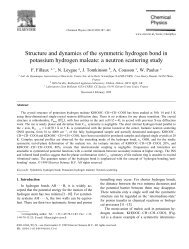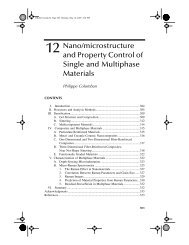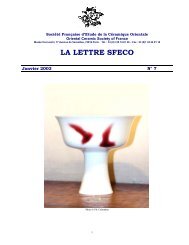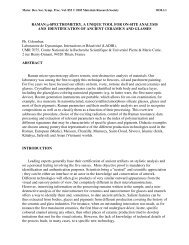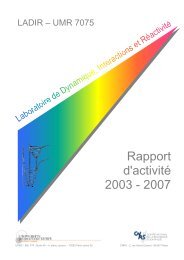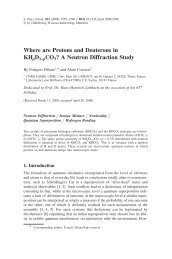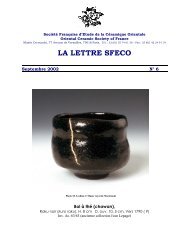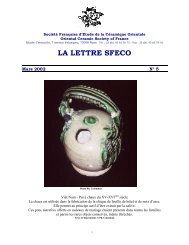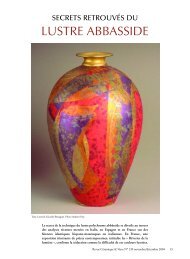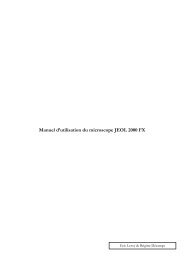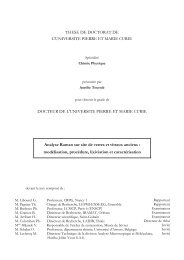Raman Spectroscopy of nanomaterials - institut de chimie et des ...
Raman Spectroscopy of nanomaterials - institut de chimie et des ...
Raman Spectroscopy of nanomaterials - institut de chimie et des ...
You also want an ePaper? Increase the reach of your titles
YUMPU automatically turns print PDFs into web optimized ePapers that Google loves.
G. Goua<strong>de</strong>c, Ph. Colomban / Progress in Crystal Growth and Characterization <strong>of</strong> Materials 3xx (2007) 1e56in a fibre coating [22]), surface-formed nanophases (corrosion mechanisms [23]) and solid-state<strong>de</strong>vices [24e27]. Some specific features can even be used to study a charge transfer [28,29],a film orientation [30], the size <strong>of</strong> clusters trapped in nano-cavities [31], Grüneisen’s param<strong>et</strong>er[32], configurational or<strong>de</strong>r (for instance the proportion <strong>of</strong> trans-gauche chains in Poly(<strong>et</strong>hylen<strong>et</strong>erephtalate)-PET [33]) or intercalation [34], interfacial [35] and polymerisation [36] reactions.The present review, which is an exten<strong>de</strong>d version <strong>of</strong> previous papers from our group[37e39], is inten<strong>de</strong>d to review the achievements <strong>of</strong> RS in the world <strong>of</strong> <strong>nanomaterials</strong>, bothfrom the fundamental and experimental points <strong>of</strong> view. The selected materials inclu<strong>de</strong> advancedand ancient ceramics, glasses, semiconductors and polymers <strong>de</strong>veloped in the form <strong>of</strong> dots,wires, films, fibres or composites for applications in the energy, electronic and aeronauticseaerospace industries. The interested rea<strong>de</strong>r will find useful complementary information inRefs. [40e43] and a special issue <strong>of</strong> the Journal <strong>of</strong> <strong>Raman</strong> <strong>Spectroscopy</strong> [44].2. The fundamentals <strong>of</strong> <strong>Raman</strong> <strong>Spectroscopy</strong>2.1. Vibrations in crystalline solidsAll collective vibrations that occur in crystals can be viewed as the superposition <strong>of</strong> plane wavesthat virtually propagate to infinity [45]. These plane waves, the so-called normal mo<strong>de</strong>s <strong>of</strong> vibration,are commonly mo<strong>de</strong>lled by quasi-particles called phonons. A normal coordinate <strong>of</strong> the formQ ¼ Q 0 cos(2pn vib t), which is actually a linear combination <strong>of</strong> bond lengths and bond angles, is associatedwith each normal mo<strong>de</strong>. Depending on the dominant term in the normal coordinate, mo<strong>de</strong>scan be classified as either str<strong>et</strong>ching (n), bending (d), torsional (t), librational (R 0 /T 0 pseudorotations/translations)or lattice mo<strong>de</strong>s (the latter inclu<strong>de</strong> the relative displacement <strong>of</strong> the unit cells).For a three-dimensional (3D) solid containing N unit cells with p atoms each, (3pN 6) differentphonons can propagate 1 and their wavevectors ð~kÞ all point in a volume <strong>of</strong> the reciprocalspace called the Brillouin Zone (BZ). 2 There are mo<strong>de</strong>s with in-phase oscillations <strong>of</strong> neighbouringatoms and mo<strong>de</strong>s with out <strong>of</strong> phase oscillations. The former are called acoustic vibrationsand the latter are called optical vibrations. On the other hand, phonons are referred to as beinglongitudinal or transversal <strong>de</strong>pending on wh<strong>et</strong>her the atoms move parallel or perpendicular tothe direction <strong>of</strong> the wave propagation given by ~k. Phonons with the same two criteria are allgathered in the BZ on 3p (discr<strong>et</strong>e) lines called the dispersion branches (see an example inFig. 17). Fig. 1 is an illustration <strong>of</strong> the concept <strong>of</strong> phonons in crystals showing the transversevibrations in a one-dimensional lattice where p ¼ 2.2.2. The <strong>Raman</strong> EffectARTICLE IN PRESS+ MODELThe polarization <strong>of</strong> the dipoles excited in solids when a laser beam (amplitu<strong>de</strong> E 0 ; frequencyn las ) interacts with phonons <strong>of</strong> frequency n vib <strong>de</strong>pends on the polarisability tensor a:~P ¼ a ~E 0 cosð2pn las tÞ ð1Þ1 There are 3pN <strong>de</strong>grees <strong>of</strong> freedom but the six rotations and translations <strong>of</strong> the whole solid are not consi<strong>de</strong>red to beproper vibrations.2 The BZ <strong>de</strong>scribes the geom<strong>et</strong>rical distribution <strong>of</strong> the wavevectors in the reciprocal space in the same way the unitcell <strong>de</strong>scribes the geom<strong>et</strong>ry and periodicity <strong>of</strong> the crystalline arrangement in the direct space.Please cite this article in press as: G. Goua<strong>de</strong>c, Ph. Colomban, Prog. Cryst. Growth Charact. Mater. (2007),doi:10.1016/j.pcrysgrow.2007.01.001



